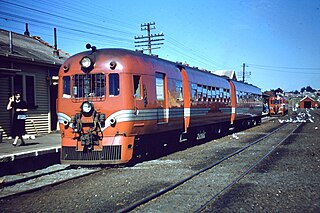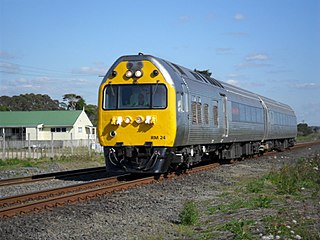Related Research Articles

Railway preservation in New Zealand is the preservation of historically significant facets of New Zealand's rail transport history. The earliest recorded preservation attempt took place in 1925, although the movement itself did not start properly until 1960.

The Rimutaka Incline was a 3-mile-long (4.8 km), 3 ft 6 in gauge railway line on an average grade of 1-in-15 using the Fell system between Summit and Cross Creek stations on the Wairarapa side of the original Wairarapa Line in the Wairarapa district of New Zealand. The term "Rimutaka Incline" is sometimes used incorrectly to refer to other parts or all of the closed and deviated section of the Wairarapa Line between Upper Hutt and Speedy's Crossing, near Featherston. The incline formation is now part of the Remutaka Rail Trail.

The NZR AB class was a class of 4-6-2 Pacific tender steam locomotive that operated on New Zealand's national railway system for New Zealand Railways (NZR). Originally an improvement on the 1906 A class, 141 were built between 1915 and 1927 by NZR's Addington Workshops, A & G Price Limited of Thames, New Zealand, and North British Locomotive Company, making the AB class the largest class of steam locomotives ever to run in New Zealand. An additional eleven were rebuilt from the tank version of the AB – the WAB class – between 1947 and 1957. Two North British-made locomotives were lost in the wreck of the SS Wiltshire in May 1922.

The NZR RM class 88-seaters were a class of railcar used in New Zealand. New Zealand Government Railways (NZR) classed them RM , the notation used for all railcars, numbering the 35 sets from RM100 to RM134. They were the most numerous railcars in NZR service, and were known unofficially as "Articulated", "Eighty Eights", "Twinsets", "Drewrys" or "Fiats". Their purchase and introduction saw the demise of steam-hauled provincial passenger trains and mixed trains.

This is a list of jargon commonly used by railfans and railway employees in New Zealand.

The Wairarapa Line is a secondary railway line in the south-east of the North Island of New Zealand. The line runs for 172 kilometres (107 mi), connects the capital city Wellington with the Palmerston North - Gisborne Line at Woodville, via Lower Hutt, Upper Hutt and Masterton.

The NZR RM class Wairarapa railcar was a class of railcars on New Zealand's national rail network. They entered service in 1936 and were classified RM like all other classes of railcars in New Zealand; they came to be known as the "Wairarapa" class as they were designed to operate over the famous Rimutaka Incline to the Wairarapa region on the Wairarapa Line. They also acquired the nickname of "tin hares" in New Zealand railfan jargon. The first two to be introduced re-used the numbers RM 4 and RM 5 that had previously been used by the withdrawn experimental Model T Ford railcars. The class consisted of six passenger railcars and one passenger-freight railcar. It is often described incorrectly as a class of six railcars.

The RM class was the classification used by the New Zealand Railways Department (NZR) and its successors gave to most railcars and railbuses that have operated on New Zealand's national rail network. "RM" stands for Rail Motor. As many types of railcars are operated, class names have been given to each railcar type to differentiate them from others.
The New Plymouth Express was a passenger express train operated by the New Zealand Railways Department (NZR) between Wellington and New Plymouth. It ran from 1886 until 1955 and was sometimes known as the New Plymouth Mail due to the Railway Travelling Post Office carriages included in its consist. The Express was notable amongst NZR's provincial expresses as being both the first and, until the commencement of the Gisborne Express in 1942, the longest in distance travelled.
The New Plymouth Night Express was a passenger express train operated by the New Zealand Railways Department (NZR) that ran between Auckland and New Plymouth. It ran in various forms from 1933 until 1983, though the Express designation was lost in 1956 and later incarnations did not operate at night and terminated in Taumarunui rather than Auckland. The New Plymouth Night Express should not be confused with the New Plymouth Express that operated between New Plymouth and Wellington.
The Wairarapa Mail was a passenger train operated by the New Zealand Railways Department (NZR) between Wellington and Woodville, continuing on to Palmerston North as a mixed train. It ran from 1909 until 1948 and its route included the famous and arduous Rimutaka Incline.
The Rewanui Branch, sometimes referred to as the Rewanui Incline and known as the Point Elizabeth Branch in its early years, was a branch line railway located in the West Coast region of New Zealand's South Island. It branched from the Midland Line near its western terminus in Greymouth and ran up to Rewanui in the Paparoa Ranges. The branch closed in 1985 but the first six kilometres to Runanga remain in operation as part of the Rapahoe Branch.
The Rimutaka Incline Railway Heritage Trust is a non-profit, charitable trust in New Zealand that was established in 2003 with the objective of reinstating an operating heritage railway over the Rimutaka Ranges using the original route of the Wairarapa Line between Maymorn and Featherston, including the world-famous Rimutaka Incline.
The Palmerston North–Gisborne Line (PNGL) is a secondary main line railway in the North Island of New Zealand. It branches from the North Island Main Trunk at Palmerston North and runs east through the Manawatū Gorge to Woodville, where it meets the Wairarapa Line, and then proceeds to Hastings and Napier in Hawke's Bay before following the coast north to Gisborne. Construction began in 1872, but the entire line was not completed until 1942. The line crosses the runway of Gisborne Airport, one of the world's only railways to do so since Pakistan's Khyber Pass Railway closed.
The Marton–New Plymouth line (MNPL) is a secondary main line railway in the North Island of New Zealand that links the Taranaki and Manawatu-Wanganui regions. It branches from the North Island Main Trunk Railway (NIMT) at Marton and runs near the South Taranaki Bight of the west coast before turning inland, meeting the Stratford–Okahukura Line (SOL) at Stratford and running to New Plymouth. Construction of the line was completed in 1885, and along with the SOL it provided an alternate route to the NIMT from the SOL's completion in 1933 until the latter was mothballed in 2010. In its early days it was plied by the North Island's first regional express, the New Plymouth Express, but it has been freight only since the cancellation of the last passenger services in 1977.
The Wanganui Branch is a 5.00 km branch line railway in the Manawatu-Wanganui region of New Zealand's North Island. It links Wanganui with the Marton - New Plymouth Line (MNPL) at Aramoho and has been open since 21 January 1878, although solely for freight traffic since 7 September 1959. Another branch line diverged from the Wanganui Branch near its terminus, the Castlecliff Branch.
The Castlecliff Branch is a branch line railway 5.88 km long in the Manawatu-Whanganui region of New Zealand's North Island. It is an extension of the Wanganui Branch from Taupo Quay in central Whanganui and follows the Whanganui River to Castlecliff on the South Taranaki Bight of the Tasman Sea. From its opening on 31 October 1885 until 1 February 1956 when the NZR took over, it was owned by the Wanganui Heads Railway Company, later renamed the Castlecliff Railway Company. From 5 September 2006 services on the branch were suspended but the infrastructure remained in place. In 2011 KiwiRail resumed services on part of the line.

Newman railway station was a station on the Wairarapa Line in the Tararua District area of the Manawatū-Whanganui region of New Zealand’s North Island. It served the small rural community of Newman, 3 kilometres (1.9 mi) north of Eketahuna. It is accessed via Cliff Road, but is now located on private property.

Fernside railway station was a flag station that served the small rural community of Fernside, north-east of Featherston in New Zealand’s North Island. It was located on the Wairarapa Line near the southern bank of the Tauherenikau River. The station opened to traffic in 1880 and closed nearly a century later in 1975.
References
- 1 2 Churchman & Hurst 2001, p. 133.
- ↑ Tony Hurst, Farewell to Steam: Four Decades of Change on New Zealand Railways (Auckland: Harper Collins Publishers, 1995), pg. 74.
- ↑ Hurst, Farewell to Steam, pg. 74.
- ↑ Rimutaka Incline Railway Heritage Trust, Steam locomotive Ab 745.